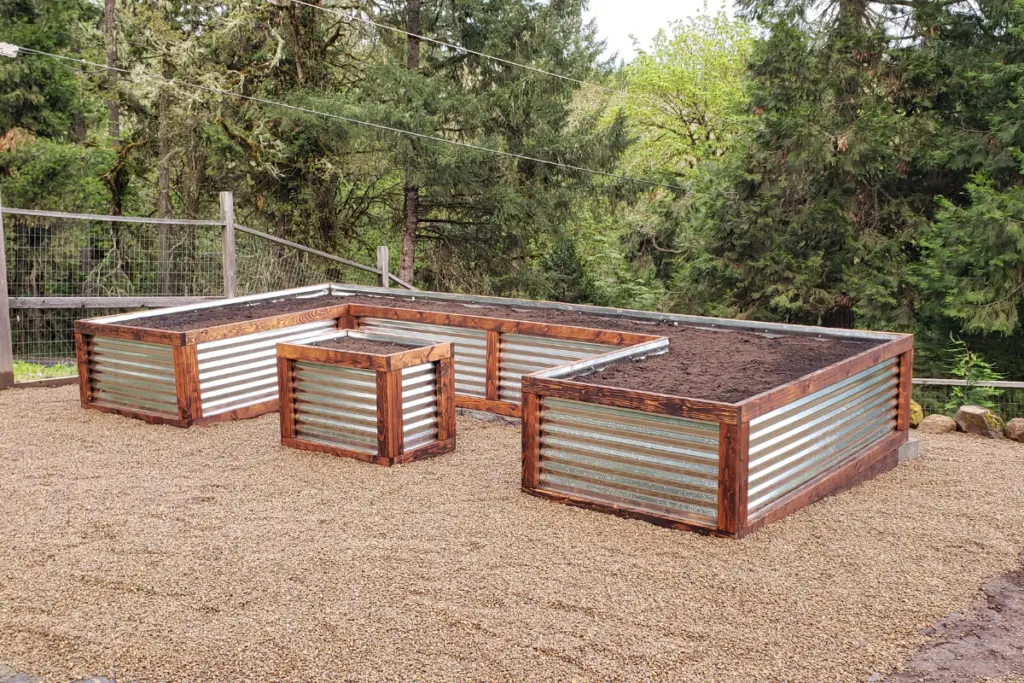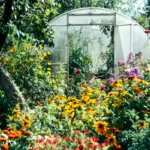Bamboo is a versatile plant that can be used for a variety of purposes, including as a decorative feature in a garden or on a patio.
One way to incorporate bamboo into your outdoor space is by building a planter box specifically designed for it.
By doing so, you can create a stunning display of bamboo while also ensuring that it has the proper environment to thrive.
When building a planter box for bamboo, there are a few key considerations to keep in mind. First, it’s important to choose the right materials.
Bamboo is a heavy plant that requires a sturdy container, so using lightweight materials like plastic or thin wood is not recommended.
Instead, opt for materials like cedar or redwood that are durable and can withstand the weight of the bamboo.
Another important factor to consider is drainage. Bamboo requires well-draining soil, so it’s important to ensure that your planter box has adequate drainage holes.
This will help prevent water from pooling at the bottom of the container, which can lead to root rot and other issues.
By following these tips and building a planter box specifically designed for bamboo, you can create a beautiful and healthy display that will enhance your outdoor space.

Table of Contents
Understanding Bamboo
Bamboo is a versatile plant that is used for a variety of purposes, from building materials to decorative accents.
When used as a planter box, bamboo can add a unique touch to any garden or patio.
Here are a few things to keep in mind when working with bamboo:
Types of Bamboo
There are two main types of bamboo: running and clumping. Running bamboo spreads quickly and can become invasive if not properly contained.
Clumping bamboo, on the other hand, grows in tight clusters and is easier to control.
When selecting bamboo for a planter box, it is important to choose a clumping variety to avoid potential problems down the line.
Bamboo Care
Bamboo is a hardy plant that can thrive in a variety of environments. However, it does require some care to ensure that it stays healthy.
Here are a few tips for caring for bamboo:
- Water regularly: Bamboo needs consistent moisture to grow properly. Be sure to water your bamboo planter box regularly, especially during hot, dry weather.
- Fertilize occasionally: Bamboo can benefit from periodic fertilization. Use a balanced fertilizer to provide the plant with the nutrients it needs to grow.
- Prune as needed: Bamboo can grow quickly, so it may need to be pruned from time to time to keep it under control. Use sharp pruning shears to remove any dead or damaged branches.
Bamboo Benefits
In addition to its aesthetic appeal, bamboo offers a number of benefits when used as a planter box.
Here are a few reasons to consider using bamboo in your garden:
- Sustainable: Bamboo is a sustainable material that grows quickly and requires little maintenance.
- Durable: Bamboo is a sturdy material that can withstand harsh weather conditions and resist pests.
- Versatile: Bamboo can be used in a variety of ways, from planter boxes to trellises to privacy screens.
By understanding the unique qualities of bamboo and taking proper care of it, you can create a beautiful and functional planter box that will enhance your outdoor space.
Choosing the Right Bamboo Species
When it comes to choosing the right bamboo species for a planter box, there are a few things to consider.
First, it’s important to choose a bamboo species that is well-suited to container growing.
Some bamboo species are better suited for this than others, so it’s important to do your research before making a selection.
One of the most important factors to consider is the size of the bamboo species.
Some bamboo species can grow very tall and wide, making them unsuitable for container growing.
Other species are more compact and better suited for growing in a planter box.
Another important factor to consider is the growth pattern of the bamboo species. Some bamboo species are clumping, which means they grow in tight clumps and are less likely to spread.
Other species are running, which means they spread quickly and can be invasive if not properly contained.
Here are a few bamboo species that are well-suited for container growing:
- Golden Goddess Bamboo: This is a clumping bamboo species that grows to about 8-10 feet tall. It has a compact growth habit and is well-suited for growing in a planter box.
- Alphonse Karr Bamboo: This is another clumping bamboo species that grows to about 10-15 feet tall. It has attractive yellow and green striped leaves and is well-suited for growing in a planter box.
- Dwarf Buddha Belly Bamboo: This is a compact bamboo species that grows to about 3-6 feet tall. It has a unique swollen stem and is well-suited for growing in a small planter box.
- Fargesia Robusta Campbell: This is a clumping bamboo species that grows to about 10-12 feet tall. It has a compact growth habit and is well-suited for growing in a planter box.
Remember to choose a bamboo species that is well-suited for your climate and growing conditions.
With the right species and a well-designed planter box, you can enjoy the beauty and benefits of bamboo in your outdoor space.
Materials Needed for a Bamboo Planter Box
Building a planter box for bamboo requires some materials that are easy to find and relatively inexpensive.
Here are the materials needed to build a bamboo planter box:
1. Bamboo poles
Bamboo poles are the main material for building a bamboo planter box. They can be purchased at many home improvement stores, garden centers, or online.
The size and quantity of bamboo poles needed depend on the size of the planter box.
Typically, 2-inch diameter bamboo poles are used for the upright walls of the planter box.
2. Wood boards
Wood boards are used to create the base of the planter box. Cedar or redwood boards are recommended as they are naturally rot-resistant and can withstand outdoor weather conditions.
The size of the boards depends on the size of the planter box.
3. Screws
Screws are used to attach the bamboo poles to the wood boards.
Stainless steel screws are recommended as they are rust-resistant and can withstand outdoor weather conditions.
4. Drill
A drill is needed to create holes in the wood boards for the screws to attach the bamboo poles.
5. Saw
A saw is needed to cut the bamboo poles and wood boards to the desired size.
6. Sandpaper
Sandpaper is needed to smooth out any rough edges on the bamboo poles and wood boards.
7. Varnish (optional)
Varnish is optional but can be applied to the wood boards for added protection against outdoor weather conditions.
By gathering these materials, one can build a sturdy and functional planter box for bamboo that can enhance any outdoor space.
Selecting the Ideal Location for Bamboo
When selecting a location for a bamboo planter box, it’s essential to consider the following factors:
Sunlight
Bamboo plants thrive in areas with ample sunlight. Ensure that the planter box is placed in a location that receives at least six hours of direct sunlight daily.
Insufficient sunlight can cause the bamboo to grow weak and leggy.
Soil Drainage
Bamboo plants require well-draining soil. If the soil is too compact, it can cause waterlogging, which can lead to root rot.
Ensure that the planter box has adequate drainage holes to prevent water from accumulating in the soil.
Space
Bamboo plants can grow to be quite large, so it’s essential to choose a location that can accommodate their growth.
Ensure that the planter box is placed in an area with enough space for the bamboo to grow tall and wide.
Wind
Bamboo plants are susceptible to damage from strong winds.
Ensure that the planter box is placed in an area protected from strong winds.
Temperature
Bamboo plants prefer warm temperatures and can be sensitive to frost. Ensure that the planter box is placed in an area protected from frost and cold temperatures.
By considering these factors, you can select an ideal location for your bamboo planter box, ensuring that your bamboo plants thrive and grow to their full potential.
Designing the Bamboo Planter Box
When building a planter box for bamboo, there are several important design considerations to keep in mind.
Here are some key factors to consider when designing a bamboo planter box:
Size and Shape
The size and shape of the planter box will depend on a few factors, including the size and number of bamboo plants you plan to grow, the amount of space you have available, and your aesthetic preferences.
Generally, bamboo plants require a lot of room to grow, so it’s important to choose a planter box that is large enough to accommodate the size of your bamboo plants.
Drainage System
One of the most important considerations when designing a bamboo planter box is the drainage system.
Bamboo plants require well-draining soil, so it’s important to ensure that your planter box has adequate drainage holes to allow excess water to escape.
You may also want to consider adding a layer of gravel or rocks at the bottom of the planter box to improve drainage.
Aesthetic Considerations
Finally, it’s important to consider the aesthetic of your planter box.
Bamboo planter boxes can be made from a variety of materials, including wood, metal, and plastic.
You may also want to consider adding decorative elements, such as bamboo slats or decorative rocks, to enhance the look of your planter box.
Building the Bamboo Planter Box
Building a planter box for bamboo is a great way to add some greenery to your outdoor space. Bamboo is a fast-growing plant that can add a tropical feel to any garden.
Here’s how to build a planter box for bamboo in a few easy steps.
Preparing the Materials
Before building the bamboo planter box, it’s important to gather all the necessary materials. Here’s a list of what you’ll need:
- Plywood
- 4×4 posts
- Screws
- Bamboo
- Wood glue
- String
Once you have all the materials, you can start building the box.
Assembling the Box
To start assembling the box, you’ll need to cut the plywood to size. Cut the plywood into four pieces, two for the sides and two for the ends.
The size of the plywood will depend on how big you want your planter box to be.
Next, cut the 4×4 posts to size. You’ll need four posts, one for each corner of the box. Secure each post to the box with at least two 3-inch-long screws in each corner.
Once the posts are secured, you can start attaching the bamboo to the top of the box.
To do this, place the bamboo in water to soften it up and then attach it (damp) to the top of the box and tie it carefully with string.
You can also add a layer of wood glue which will strengthen the bond. Tie as many knots as you can to make an attractive pattern.
Adding the Drainage System
To prevent your bamboo from getting waterlogged, you’ll need to add a drainage system to the planter box.
To do this, drill several holes in the bottom of the plywood. The plywood is the bottom of your planter box, and each hole in the plywood is a drainage hole.
Once the drainage holes are drilled, you can add a layer of gravel to the bottom of the box. This will help with drainage and prevent the roots from getting waterlogged.
Planting the Bamboo
Preparing the Soil
Before planting the bamboo, it’s important to prepare the soil properly. Bamboo requires well-draining soil that is rich in organic matter.
The pH level of the soil should be between 6 and 6.5. Here are the steps to prepare the soil:
- Loosen the soil to a depth of 12-18 inches using a garden fork or tiller.
- Mix in organic matter such as compost, aged manure, or leaf mold. This will improve the soil’s structure, fertility, and water-holding capacity.
- Test the soil’s pH level using a soil test kit. If the pH level is too low, add lime to raise it. If it’s too high, add sulfur to lower it.
- Water the soil thoroughly and let it settle for a few days before planting.
Planting Procedure
Once the soil is ready, it’s time to plant the bamboo.
Here are the steps to follow:
- Choose a container that is at least 2-3 times larger than the bamboo’s root ball. If you’re planting bamboo in the ground, dig a hole that is slightly larger than the root ball.
- Place a layer of gravel or broken pottery at the bottom of the container or hole. This will improve drainage and prevent the roots from sitting in water.
- Gently remove the bamboo from its current container or loosen the roots if it’s balled and burlapped. Be careful not to damage the roots.
- Place the bamboo in the center of the container or hole and backfill with soil. Make sure the bamboo is planted at the same depth it was in its previous container or in the ground.
- Water the bamboo thoroughly and add more soil if needed to fill any settling that may occur.
It’s important to note that bamboo can easily outgrow its container or planting area.
Therefore, it’s recommended to repot or divide the bamboo every 2 to 5 years to prevent it from becoming root-bound.
Bamboo Care and Maintenance
Growing bamboo in a planter box requires proper care and maintenance to ensure its healthy growth.
This section will discuss the essential care and maintenance practices for bamboo in planter boxes.
Watering
Bamboo requires regular watering to thrive. The frequency of watering depends on the climate, humidity, and the size of the planter box.
In general, bamboo in planter boxes should be watered deeply once or twice a week.
The soil should be kept moist but not waterlogged. Overwatering can lead to root rot and other fungal diseases.
Pruning
Pruning is an essential part of bamboo care and maintenance. It helps to control the size and shape of the plant and promotes healthy growth.
Bamboo in planter boxes should be pruned annually to remove dead or damaged canes and thin out the plant to allow for better air circulation.
Pruning should be done in the early spring before new growth appears.
Fertilizing
Bamboo in planter boxes requires regular fertilization to ensure its healthy growth. A balanced, slow-release fertilizer is recommended.
Fertilizers with high nitrogen content should be avoided as they can lead to excessive growth and weak canes. Fertilizer should be applied in the early spring and late summer.
Conclusion
In conclusion, building a planter box for bamboo is a simple and rewarding project that can add a touch of greenery to any space.
With the right tools and materials, you can create a sturdy and attractive planter box that will provide a home for your bamboo plants for years to come.
Remember to choose the right type of bamboo for your climate and to provide adequate drainage and watering for your plants.
With a little bit of effort and creativity, you can create a beautiful and functional addition to your garden or home.
- How to Dry Basil Leaves: A Professional Guide
- Is an Avocado a Fruit or Vegetable? Simple Answer and Explanation
- Does Pineapple Have Seeds? Exploring the Anatomy of Pineapples
- Blooming Through Winter: Can I Grow Vegetables Indoors in the Winter?
- What Can You Grow in a Greenhouse All Year Round: A Guide to Year-Round Greenhouse Gardening
- Are Blueberries Blue? Debunking the Myth of Their Color
















